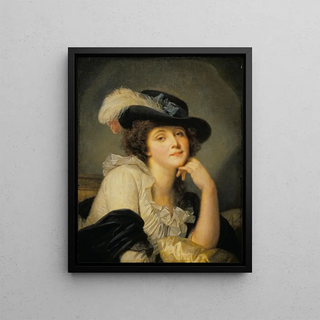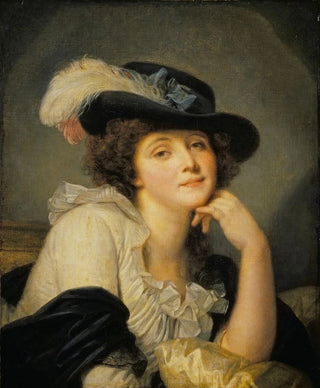Art print | Portrait of a woman - Jean-Baptiste Greuze


View from behind

Frame (optional)
The "Portrait of a Woman" by Jean-Baptiste Greuze is a work that transcends the simple frame of painting to establish itself as a true reflection of human emotions. Created in the 18th century, this painting embodies the very essence of the classical portrait, while infusing it with a psychological depth rarely achieved. The grace and delicacy emanating from this woman's face captivate the viewer and invite prolonged contemplation. Every detail, from the gaze to the expression, seems to tell a story, a life, a personality. Immersing oneself in this artwork, the spectator is transported to a universe where art and the human soul meet, thus revealing the evocative power of painting.
Style and uniqueness of the work
Greuze stands out for his ability to merge realism and idealization. In this art print, the finesse of the features and the brightness of the colors demonstrate exceptional technical mastery. The play of light accentuates the volumes of the face, while the neutral background highlights the central figure, creating a contrast that draws the eye. The artist manages to capture not only the physical appearance of his model but also a palpable emotion, an introspection that seems suspended in time. The delicate and slightly tilted posture of the woman suggests vulnerability, while maintaining a majestic dignity. This subtle blend of emotions gives the work an almost timeless dimension, allowing the viewer to project themselves into it and find echoes of their own feelings.
The artist and his influence
Jean-Baptiste Greuze, an emblematic figure of the rococo movement, knew how to mark his era with an innovative approach to the art print. By moving away from the strict conventions of his predecessors, he paved the way for a more human and accessible representation of subjects. His style, imbued with sensitivity, influenced many artists, both contemporaries and successors. Greuze also captured the spirit of the times, reflecting the social and emotional concerns of his era through his works. His commitment to depicting everyday life and human emotions allowed him to give a new dimension to portrait art, making him a pioneer in this field.

Matte finish

View from behind

Frame (optional)
The "Portrait of a Woman" by Jean-Baptiste Greuze is a work that transcends the simple frame of painting to establish itself as a true reflection of human emotions. Created in the 18th century, this painting embodies the very essence of the classical portrait, while infusing it with a psychological depth rarely achieved. The grace and delicacy emanating from this woman's face captivate the viewer and invite prolonged contemplation. Every detail, from the gaze to the expression, seems to tell a story, a life, a personality. Immersing oneself in this artwork, the spectator is transported to a universe where art and the human soul meet, thus revealing the evocative power of painting.
Style and uniqueness of the work
Greuze stands out for his ability to merge realism and idealization. In this art print, the finesse of the features and the brightness of the colors demonstrate exceptional technical mastery. The play of light accentuates the volumes of the face, while the neutral background highlights the central figure, creating a contrast that draws the eye. The artist manages to capture not only the physical appearance of his model but also a palpable emotion, an introspection that seems suspended in time. The delicate and slightly tilted posture of the woman suggests vulnerability, while maintaining a majestic dignity. This subtle blend of emotions gives the work an almost timeless dimension, allowing the viewer to project themselves into it and find echoes of their own feelings.
The artist and his influence
Jean-Baptiste Greuze, an emblematic figure of the rococo movement, knew how to mark his era with an innovative approach to the art print. By moving away from the strict conventions of his predecessors, he paved the way for a more human and accessible representation of subjects. His style, imbued with sensitivity, influenced many artists, both contemporaries and successors. Greuze also captured the spirit of the times, reflecting the social and emotional concerns of his era through his works. His commitment to depicting everyday life and human emotions allowed him to give a new dimension to portrait art, making him a pioneer in this field.






